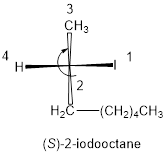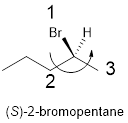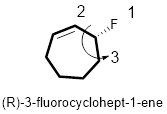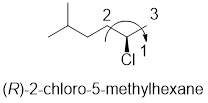
Concept explainers
(a)
Interpretation:
The IUPAC name of the given compound has to be written.
Concept Introduction:
Isomers: Compounds that have same molecular formula but different structural formula.
Constitutional isomers: Compounds that have same molecular formula but different connectivity (arrangement of atoms are different).
Nomenclature of organic compounds:
The naming of the organic compound is given by IUPAC (International Union for pure and applied chemistry). In the IUPAC names consist of certain rules for giving chemical names they are,
- The longer number of Carbon chain of a compound is identified is called parent of the compound.
- In the cyclic compounds the number of carbon involving in ring formation is called parent of the compound.
- The compound have more than one parent chains means the larger number of substitutions present in the chain is consider as a parent chain.
- The names of all substituents are arranged by alphabets to starts with lowest numbering.
- In the complex substituent having compounds the substituent name is assigned by a name each of them based on numbers going away from the parent.
(a)
Explanation of Solution
Compound (a):

In the given compound, the longest carbon chain (highlighted with bold lines) contains six carbons and while numbering the parent chain, substituents should get the least possible number.
The presence of double bond at C-2 makes parent name as 2-hexene. The substituents Bromine atom at C-2; are arranged in alphabetical order followed by the parent name.
Therefore, the systematic name of the given compounds is ‘2-bromo-2-hexene’.
(b)
Interpretation:
The IUPAC name and configuration of the given compound has to be written.
Concept Introduction:
Nomenclature of organic compounds:
The naming of the organic compound is given by IUPAC (International Union for pure and applied chemistry). In the IUPAC names consist of certain rules for giving chemical names they are,
- The longer number of Carbon chain of a compound is identified this is called parent of the compound.
- In the cyclic compounds the number of carbon involving in ring formation is called parent of the compound.
- The compound have more than one parent chains means the larger number of substitutions present in the chain is consider as a parent chain.
- The names of all substituents are arranged by alphabets to starts with lowest numbering.
- In the complex substituent having compounds the substituent name is assigned by a name each of them based on numbers going away from the parent.
R and S nomenclature:
It is used to assign the molecule using CIP rules.
The CIP rules are as follows:
- Select the chiral carbon and assign the numbers according to the decreasing
atomic mass of atoms attached to it. - If the numbering follows clockwise direction then the atom is termed as R and if it follows anti-clockwise direction then atom is termed as S.
(b)
Explanation of Solution
Compound (b):

In the given compound, the longest carbon ring (highlighted with bold lines) contains six carbons and while numbering the parent chain, substituents should get the least possible number.
The presence of double bond at C-1 makes parent name is hex-1-ene. The substituents methyl located at C-3 and bromine atom at C-3; are arranged in alphabetical order followed by the parent name.
The chiral carbon and assign the numbers according to the decreasing atomic mass of atoms attached to it, follows clockwise direction then the atom is termed as R
Therefore, the systematic name of the given compounds is ‘3-bromo-3-methylcyclohex-1-ene’.
(c)
Interpretation:
The IUPAC name and configuration of the given compound has to be written.
Concept Introduction:
Nomenclature of organic compounds:
The naming of the organic compound is given by IUPAC (International Union for pure and applied chemistry). In the IUPAC names consist of certain rules for giving chemical names they are,
- The longer number of Carbon chain of a compound is identified this is called parent of the compound.
- In the cyclic compounds the number of carbon involving in ring formation is called parent of the compound.
- The compound have more than one parent chains means the larger number of substitutions present in the chain is consider as a parent chain.
- The names of all substituents are arranged by alphabets to starts with lowest numbering.
- In the complex substituent having compounds the substituent name is assigned by a name each of them based on numbers going away from the parent.
In a cis isomer, groups are attached on the same side of the ring.
In a trans isomer, groups are attached on the opposite side of the ring.
(c)
Explanation of Solution
Compound (c):

In the given compound, the longest carbon ring (highlighted with bold lines) contains six carbons and while numbering the parent chain, substituents should get the least possible number.
The parent name is CYCLOHEXANE. The substituents bromine atoms are at C-1and C-4; are arranged in alphabetical order followed by the parent name. Here, bromine atoms are attached on the opposite side of the ring thus ‘trans’.
Therefore, the systematic name of the given compounds is ‘trans 1,4-dibromocyclohexane’.
(d)
Interpretation:
The IUPAC name of the given compound has to be written.
Concept Introduction:
Nomenclature of organic compounds:
The naming of the organic compound is given by IUPAC (International Union for pure and applied chemistry). In the IUPAC names consist of certain rules for giving chemical names they are,
- The longer number of Carbon chain of a compound is identified this is called parent of the compound.
- In the cyclic compounds the number of carbon involving in ring formation is called parent of the compound.
- The compound have more than one parent chains means the larger number of substitutions present in the chain is consider as a parent chain.
- The names of all substituents are arranged by alphabets to starts with lowest numbering.
- In the complex substituent having compounds the substituent name is assigned by a name each of them based on numbers going away from the parent.
(d)
Explanation of Solution
Compound (d):

In the given compound, the longest carbon chain (highlighted with bold lines) contains four carbons and while numbering the parent chain, substituents should get the least possible number.
The parent name is butane. The substituents chlorine atom at C-1 and C-4; are arranged in alphabetical order followed by the parent name.
Therefore, the systematic name of the given compounds is ‘1,4-dichlorobutane’.
(e)
Interpretation:
The IUPAC name and configuration of the given compound has to be written.
Concept Introduction:
Nomenclature of organic compounds:
The naming of the organic compound is given by IUPAC (International Union for pure and applied chemistry). In the IUPAC names consist of certain rules for giving chemical names they are,
- The longer number of Carbon chain of a compound is identified this is called parent of the compound.
- In the cyclic compounds the number of carbon involving in ring formation is called parent of the compound.
- The compound have more than one parent chains means the larger number of substitutions present in the chain is consider as a parent chain.
- The names of all substituents are arranged by alphabets to starts with lowest numbering.
- In the complex substituent having compounds the substituent name is assigned by a name each of them based on numbers going away from the parent.
R and S nomenclature:
It is used to assign the molecule using CIP rules.
The CIP rules are as follows:
- Select the chiral carbon and assign the numbers according to the decreasing atomic mass of atoms attached to it.
- If the numbering follows clockwise direction then the atom is termed as R and if it follows anti-clockwise direction then atom is termed as S.
(e)
Explanation of Solution
Compound (e):

In the given compound, the longest carbon ring contains eight carbons and while numbering the parent chain, substituents should get the least possible number. The parent name is octane. The substituents iodine atom located at C-2; are arranged in alphabetical order followed by the parent name.
The numbering follows clockwise direction as shown above then it is termed as R. Least priority group is above the plane so the configuration is reversed.
Therefore, the systematic name of the given compounds is ‘(S)-2-iodooctane’.
(f)
Interpretation:
The IUPAC name and configuration of the given compound has to be written.
Concept Introduction:
Nomenclature of organic compounds:
The naming of the organic compound is given by IUPAC (International Union for pure and applied chemistry). In the IUPAC names consist of certain rules for giving chemical names they are,
- The longer number of Carbon chain of a compound is identified this is called parent of the compound.
- In the cyclic compounds the number of carbon involving in ring formation is called parent of the compound.
- The compound have more than one parent chains means the larger number of substitutions present in the chain is consider as a parent chain.
- The names of all substituents are arranged by alphabets to starts with lowest numbering.
- In the complex substituent having compounds the substituent name is assigned by a name each of them based on numbers going away from the parent.
R and S nomenclature:
It is used to assign the molecule using CIP rules.
The CIP rules are as follows:
- Select the chiral carbon and assign the numbers according to the decreasing atomic mass of atoms attached to it.
- If the numbering follows clockwise direction then the atom is termed as R and if it follows anti-clockwise direction then atom is termed as S.
(f)
Explanation of Solution
Compound (f):

In the given compound, the longest carbon ring (highlighted with bold lines) contains five carbons and while numbering the parent chain, substituents should get the least possible number.
The parent name is hexane. The substituents bromine atom located at C-2; are arranged in alphabetical order followed by the parent name.
The chiral carbon and assign the numbers according to the decreasing atomic mass of atoms attached to it, follows anti-clockwise direction then atom is termed as S.
Therefore, the systematic name of the given compounds is ‘(S)-2-bromopentane’.
(g)
Interpretation:
The IUPAC name and configuration of the given compound has to be written.
Concept Introduction:
Nomenclature of organic compounds:
The naming of the organic compound is given by IUPAC (International Union for pure and applied chemistry). In the IUPAC names consist of certain rules for giving chemical names they are,
- The longer number of Carbon chain of a compound is identified this is called parent of the compound.
- In the cyclic compounds the number of carbon involving in ring formation is called parent of the compound.
- The compound have more than one parent chains means the larger number of substitutions present in the chain is consider as a parent chain.
- The names of all substituents are arranged by alphabets to starts with lowest numbering.
- The complex substituent is built by a substituent on a substituent; so called complex substituent.
- In the complex substituent having compounds the substituent name is assigned by a name each of them based on numbers going away from the parent.
R and S nomenclature:
It is used to assign the molecule using CIP rules.
The CIP rules are as follows:
- Select the chiral carbon and assign the numbers according to the decreasing atomic mass of atoms attached to it.
- If the numbering follows clockwise direction then the atom is termed as R and if it follows anti-clockwise direction then atom is termed as S.
(g)
Explanation of Solution
Compound (g):

In the given compound, the longest carbon ring (highlighted with bold lines) contains seven carbons in a ring and while numbering the parent chain, substituents should get the least possible number.
The presence of double bond at C-1 on the ring makes parent name is cyclohept-1-ene. The substituents Fluorine atom located at C-3; are arranged in alphabetical order followed by the parent name.
The chiral carbon and assign the numbers according to the decreasing atomic mass of atoms attached to it, follows anti-clockwise direction then atom is termed as S. Least priority group is above the plane so the configuration is reversed. Hence, the configuration is (R).
Therefore, the systematic name of the given compounds is ‘(R)- 3-fluorocyclohept-1-ene’.
(h)
Interpretation:
The IUPAC name of the given compound has to be written.
Concept Introduction:
Nomenclature of organic compounds:
The naming of the organic compound is given by IUPAC (International Union for pure and applied chemistry). In the IUPAC names consist of certain rules for giving chemical names they are,
- The longer number of Carbon chain of a compound is identified this is called parent of the compound.
- In the cyclic compounds the number of carbon involving in ring formation is called parent of the compound.
- The compound have more than one parent chains means the larger number of substitutions present in the chain is consider as a parent chain.
- The names of all substituents are arranged by alphabets to starts with lowest numbering.
- The complex substituent is built by a substituent on a substituent; so called complex substituent.
- In the complex substituent having compounds the substituent name is assigned by a name each of them based on numbers going away from the parent.
(h)
Explanation of Solution
Compound (h):

In the given compound, the longest carbon chain (highlighted with bold lines) contains three carbons and while numbering the parent chain, substituents should get the least possible number.
The parent name is Propane. The substituents methyl located at C-2 and bromine atom at C-1; are arranged in alphabetical order followed by the parent name.
Therefore, the systematic name of the given compounds is ‘1-bromo-2-methylpropane’.
(i)
Interpretation:
The IUPAC names and configuration of the given compound has to be written.
Concept Introduction:
Nomenclature of organic compounds:
The naming of the organic compound is given by IUPAC (International Union for pure and applied chemistry). In the IUPAC names consist of certain rules for giving chemical names they are,
- The longer number of Carbon chain of a compound is identified this is called parent of the compound.
- In the cyclic compounds the number of carbon involving in ring formation is called parent of the compound.
- The compound have more than one parent chains means the larger number of substitutions present in the chain is consider as a parent chain.
- The names of all substituents are arranged by alphabets to starts with lowest numbering.
- In the complex substituent having compounds the substituent name is assigned by a name each of them based on numbers going away from the parent.
(i)
Explanation of Solution
Compound (i):

In the given compound, the longest carbon chain (highlighted with bold lines) contains six carbons and while numbering the parent chain, substituents should get the least possible number.
The parent name is hexane. The substituents methyl located at C-5 and chlorine atom at C-2; are arranged in alphabetical order followed by the parent name.
The chiral carbon and assign the numbers according to the decreasing atomic mass of atoms attached to it, follows clockwise direction then the atom is termed as R.
Therefore, the systematic name of the given compounds is ‘(R)-2-chloro-5-methylhexane’.
Want to see more full solutions like this?
Chapter 8 Solutions
Organic Chemistry
- Write the systematic name of each organic molecule: structure i HO OH Explanation Check name ☐ ☐arrow_forwardX 5 Check the box under each molecule that has a total of five ẞ hydrogens. If none of the molecules fit this description, check the box underneath the table. CI Br Br Br 0 None of these molecules have a total of five ẞ hydrogens. Explanation Check esc F1 F2 tab caps lock fn Q @2 A W # 3 OH O OH HO © 2025 McGraw Hill LLC. All Rights Reserved. Terms of Use | Privacy Center | Accessibility IK F7 F7 F8 TA F9 F10 & 6 28 * ( > 7 8 9 0 80 F3 O F4 KKO F5 F6 S 64 $ D % 25 R T Y U பட F G H O J K L Z X C V B N M H control option command P H F11 F12 + || { [ command optionarrow_forwardAn open vessel containing water stands in a laboratory measuring 5.0 m x 5.0 m x 3.0 m at 25 °C ; the vapor pressure (vp) of water at this temperature is 3.2 kPa. When the system has come to equilibrium, what mass of water will be found in the air if there is no ventilation? Repeat the calculation for open vessels containing benzene (vp = 13.1 kPa) and mercury (vp = 0.23 Pa)arrow_forward
- Every chemist knows to ‘add acid to water with constant stirring’ when diluting a concentrated acid in order to keep the solution from spewing boiling acid all over the place. Explain how this one fact is enough to prove that strong acids and water do not form ideal solutions.arrow_forwardThe predominant components of our atmosphere are N₂, O₂, and Ar in the following mole fractions: χN2 = 0.780, χO2 = 0.21, χAr = 0.01. Assuming that these molecules act as ideal gases, calculate ΔGmix, ΔSmix, and ΔHmix when the total pressure is 1 bar and the temperature is 300 K.arrow_forwarddG = Vdp - SdT + μA dnA + μB dnB + ... so that under constant pressure and temperature conditions, the chemical potential of a component is the rate of change of the Gibbs energy of the system with respect to changing composition, μJ = (∂G / ∂nJ)p,T,n' Using first principles prove that under conditions of constant volume and temperature, the chemical potential is a measure of the partial molar Helmholtz energy (μJ = (∂A / ∂nJ)V,T,n')arrow_forward
- The vapor pressure of dichloromethane at 20.0 °C is 58.0 kPa and its enthalpy of vaporization is 32.7 kJ/mol. Estimate the temperature at which its vapor pressure is 66.0 kPa.arrow_forwardDraw the structure of A, the minor E1 product of the reaction. Cl Skip Part Check F1 esc CH_CH OH, D 3 2 Click and drag to start drawing a structure. 80 R3 F4 F2 F3 @ 2 # $ 4 3 Q W 95 % KO 5 F6 A F7 × G ☐ Save For Later Sub 2025 McGraw Hill LLC. All Rights Reserved. Terms of Use | Privacy C ►II A A F8 F9 F10 FL 6 7 88 & * 8 9 LLI E R T Y U A S D lock LL F G H 0 P J K L Z X C V B N M 9 Harrow_forwardFrom the choices given, which two substances have the same crystal structure? (Select both) Group of answer choices ZnS (zincblende) Diamond TiO2 (rutile) ZnS (wurtzite)arrow_forward
- Potassium (K) blends with germanium (Ge) to form a Zintl phase with a chemical formula of K4Ge4. Which of the following elements would you expect potassium to blend with to form an alloy? Electronegativities: As (2.0), Cl (3.0), Ge (1.8), K (0.8), S (2.5), Ti (1.5) Group of answer choices Arsenic (As) Sulfur (S) Chlorine (Cl) Titanium (Ti)arrow_forwardConsider two elements, X and Z. Both have cubic-based unit cells with the same edge lengths. X has a bcc unit cell while Z has a fcc unit cell. Which of the following statements is TRUE? Group of answer choices Z has a larger density than X X has more particles in its unit cell than Z does X has a larger density than Z Z has a larger unit cell volume than Xarrow_forwardHow many particles does a face-centered cubic (fcc) unit cell contain? Group of answer choices 2 14 8 4arrow_forward
 Organic ChemistryChemistryISBN:9781305580350Author:William H. Brown, Brent L. Iverson, Eric Anslyn, Christopher S. FootePublisher:Cengage Learning
Organic ChemistryChemistryISBN:9781305580350Author:William H. Brown, Brent L. Iverson, Eric Anslyn, Christopher S. FootePublisher:Cengage Learning
